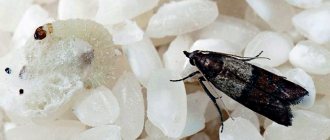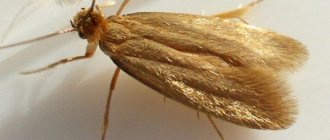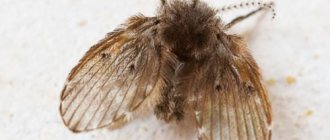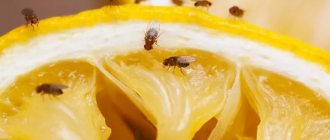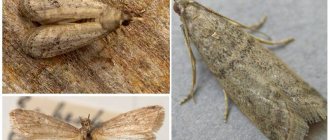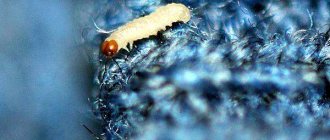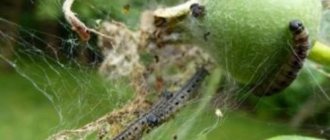The list of domestic insect pests also includes food moths. Kitchen moths should not be confused with clothes moths, since their larvae do not harm wool and fur items, but bulk food products.
Food moth larvae feed on:
- cereals and flakes;
- nuts and legumes;
- prepared animal feed;
- dried fruits.
Insects cause serious damage to household grocery stocks, so when they are detected, it is necessary to immediately begin to destroy the adults and their larvae.
Types and description of the pest
The kitchen moth is similar in appearance to its relative. For this reason, it is not difficult to describe what a food moth looks like. The adult is a small, inconspicuous butterfly. The length of its body varies between 10-12 mm, and the wingspan is on average about 8 mm.
In the kitchen you can find one of several varieties of food moths.
- The flour moth is distinguished by the brown color of its wings. They are lighter closer to the body, and have dark triangles at the edges.
- The bread moth (barn or grain moth) has a straw or gray-yellow color and a wavy fringe along the edges of the wings.
- The fruit moth differs from the others by stripes on the surface of the wing.
- The cocoa moth has a light yellow tint to its wings.
Having noticed small butterflies in the kitchen, it makes sense to compare their appearance with a photo of a food moth.
The difference between the food moth and its clothes relative
To accurately determine the type of pest, you need to know that clothes moths are slightly larger than food pests. Adult kitchen moths lack the pearlescent tint on their wings that is characteristic of clothes moths.
The larvae cannot be identified externally due to their similarity. However, this can be easily done by the way they are fed. Kitchen moth larvae feed on grocery products, and clothes moths lay eggs on the surface of woolen items, hats, fur coats or carpets.
General information about moths
A moth is a small insect that is nocturnal. The main pests are larvae. The pest looks like a moth, but its distinguishing feature is the absence of a trunk. Insects consume food using their jaws, which crush grains, seeds of fruits, and plants.
The answer to the question of how long a moth lives is 2-4 weeks. It flies infrequently and mainly at twilight. The pest organism is capable of accumulating energy reserves, since adult butterflies do not feed or digest food; their task is to reproduce.
Let's look at how moths reproduce:
- Females lay eggs in a warm place, and after 2 weeks larvae are born.
- The larvae absorb food, accumulate energy and turn into caterpillars.
- Having eaten enough, the parasite pupates. After 2 months of being in the cocoon, an adult butterfly appears.
The moth's wings reach 0.7 cm and at rest look like a triangle. It is difficult to find moths in an apartment, because the butterfly is inconspicuous and inconspicuous.
Varieties of moths in the house
There are several types of insects that can be divided into 2 groups: food and clothing pests. From the name it is clear that some moths parasitize on the things and clothes of the owners of the apartment, others on food. The following types of butterflies are distinguished:
- Fur coat. The moth itself is yellow in color, reaches a size of 1.6 cm, and does no harm because it does not feed. But such individuals lay eggs, from which larvae emerge that resemble worms. Worms voraciously eat the fur of hats, fur coats and collars.
- Clothes. The size reaches 2 cm, the wings are yellow with a purple base. The caterpillars have the same appearance as the fur coat butterfly, but they live in the folds of fabrics and woolen clothing.
- Furniture. This moth in the apartment lays eggs on the upholstery of upholstered furniture and in the cracks of wooden products. The larvae eat the upholstery, then the wood. The pest is small, the size does not exceed 1 cm with a wingspan, the color is light yellow, brown at the base of the wing.
- Carpet. The larvae eat carpets and fur, and even leather products - outerwear, boots and bags.
- Food. Lives in food: cereals, grains, flour, etc.
Signs of appearance
It is not easy to notice the appearance of a pest in the house at the initial stage. Adults are nocturnal. During the day they hide from sunlight in secluded corners. When the light is on, they immediately try to hide.
Note!
Melamine sponge - how to use correctly? All the pros and cons of the miracle sponge
How to descale a kettle: vinegar, citric acid, soda, brine, soda. TOP most effective cleaning methods!
Blinds for the kitchen: how to choose, what they are, photos of new designs
Characteristic signs of the presence of a pest in an apartment are:
- small butterflies in the kitchen or pantry, as well as on containers with bulk products;
- small translucent worms with a dark head in food cabinets and containers with groceries;
- lumps in the cereal with dust, cobwebs and a worm inside.
An indirect sign of the vital activity of the larvae is small dust on shelves and in food containers.
You should know that food moths in an apartment live only in rooms where food is located, since they are the food source for the larvae.
How to recognize poplar moth by sight
He will tell you what a poplar moth looks like - photo. If you strain your memory, these are the kinds of insects that accumulate on lighting fixtures, near TVs, and behind curtains during the June “downfall.” Of course, the abundance of insects negatively affects the sanitary condition of the home. Its presence is especially unacceptable if there are small children or allergy sufferers in the house.
Important! The poplar moth parasitizes mainly on poplars, although sometimes it chooses maples, so in places where this tree grows, you also need to be vigilant.
Interestingly, apart from irritation and discomfort, poplar moths do not cause physical harm. That is, it does not spoil food, does not make bald spots in fur coats, does not gnaw holes in woolen items - there is nothing “edible” for insects of this type in the house/apartment. Well, then she is attracted to living quarters. Everything is very simple - it is convenient for her to reproduce in a home environment. Despite the fact that the life cycle of an adult is only 72 hours, during this period the female manages to lay eggs three times, from which larvae instantly form and then turn into mature butterflies. Clutches of poplar moth eggs can be found in places loved by its other “brethren” - in bags of cereals, flour, dried fruits, etc.
Adult poplar moth
It is worth noting that, although this insect does not spoil things and products in the house, but, as stated above, it is capable of penetrating electrical lighting devices, as well as televisions, computers, etc. As a result, the devices may not function properly, or even completely fail.
Attention! The larva of the poplar moth is characterized by a yellowish-white color, and on the front wings there is a variegated grayish-brown pattern. It reaches 5 mm in length. The wingspan of an adult is 8–10 mm.
What do food moths eat?
The kitchen moth causes the main damage to grocery products in the larval stage. Worm larvae are very voracious. Once in food packaging, they leave behind various waste products from their life activity:
- excrement;
- scales;
- other waste.
Depending on the type of pest, the following may be affected:
- cereals;
- pasta;
- processed cereals;
- bakery products;
- nuts;
- dried fruits;
- confectionery;
- legumes;
- flour;
- tea;
- various seasonings.
The larvae can spoil the supply of ready-made dry animal feed, grain or seeds of garden plants.
If worms penetrate into the packaging of the product, it becomes unsuitable for consumption. Thick paper bags or plastic bags are not an obstacle for the larvae.
At the same time, the pest is not dangerous for fur and woolen items due to the inability to digest natural fibers.
The point of view of an entomologist
Several years ago, the Moscow press repeatedly published publications that residents of Moscow and the region were being attacked by poplar moths. Without exaggeration, entire hordes of this insect were observed on the streets. On pedestrian paths, entire “carpets” were formed from this insect. Naturally, the premises, both residential and public, were full of these butterflies. In such a situation, the residents of Fr.
Poplar moth in the larval stage
Entomologist Gennady Lyubarevsky, Candidate of Biological Sciences, commented on the current situation: “It is difficult to explain in simple terms such a rapid growth of the poplar moth population. Various factors can influence this, including weather conditions and the availability of large amounts of food. Most likely, in this case, both occur, which led to an outbreak in numbers. First of all, these insects infect poplars - black, laurel, and balsam. And, if the population is very large, then they do not disdain trees of other species. Owners of apartments and houses of old buildings suffer most from the invasion of this parasite. Insects spend the winter there on balconies, in hallways, attics and basements.”
Harm from food moths
When you detect the first signs of the presence of food moths in the kitchen, you should make every effort to destroy it.
Note!
Spatulas for the kitchen - which one to choose? Silicone, metal or ceramic? TOP 110 photos of new products for the kitchen
How to wash a microwave: the best ways to quickly clean a dirty microwave with your own hands
What temperature should the refrigerator be: setting the temperature mode + rating of the best models of 2021
Adults do not pose a danger to human health, except that they may accidentally fall into a cup of tea or a bowl of soup, thus spoiling the contents. The larvae, when they get into packaging with bulk products, make them unfit for consumption. Contaminated products entering the human body can provoke:
- development of an allergic reaction;
- digestive disorders;
- decreased local immunity;
- poisoning.
Moving through kitchen cabinets in search of food, worms are capable of carrying various infections.
In addition, the very fact of the presence of a food pest in a room with food products causes serious psychological discomfort among the inhabitants of the apartment.
Measures to protect your home from food moth infestation
Knowing how to kill food moths is useful, but not enough to protect the premises from the pest. It is much wiser not to let him into the house at all, taking several steps to prevent infestation of the apartment with food moths. Among these measures:
- thorough check of all products upon purchase
- avoidance of grocery products with obviously low prices
- purchasing food that will be eaten within one week
- use of moth repellents.
To comply with the last point, it is useful to know what food moths are afraid of. Among the substances that repel it are strong-smelling herbs (wormwood, tansy, lavender, rosemary), essential oils, fresh orange peels, laundry and strawberry soap, vinegar, horse chestnut cones.
It is only important to remember that if, for example, you place a jar of moth-infested semolina in a cabinet with neatly laid out lavender, the larvae in the cereal will not die, and the butterflies that appear later will no longer be afraid of the lavender itself. That is why it is so important to implement all preventive measures in a comprehensive manner.
341
Reasons for the appearance of moths in the kitchen
It should be understood that moths cannot start on their own. It always comes from outside. For this reason, the owner of even the most sterile kitchen may face the task of removing food moths.
Adults are able to enter the apartment through an open window, vent or ventilation hole. It is only a matter of time before the pest spreads further. The risk of moths appearing is especially high in apartment buildings where there is a grocery store or catering outlet on the ground floor.
Often, food moths appear in an apartment after purchasing food, feed or seeds contaminated with larvae. Protective measures include screens on windows and ventilation openings, as well as careful inspection of food, seed or feed packages before purchase.
How to get rid of moths
If flying moths were not found in the apartment, this does not mean that worms did not appear in it. A barely noticeable web will finally confirm their presence. It's a good idea to get into the habit of looking through your "strategic" supplies from time to time. If a food moth gets into a jar of cereals and flour products, despite the humidity and lack of air access, it will seriously spoil them.
The appearance of a moth indicates that its future offspring will very soon begin devouring failed porridges and casseroles. Once inside a home, the pest causes great damage not only to food. It is dangerous for the human body.
Purchased funds
If the moth has “taken over” the territory, you will have to resort to radical methods. To completely overcome the scourge, an integrated approach will be required. A universal remedy for instantly eliminating food moths has not yet been invented. But certain tools have been successfully used for decades.
Mechanical traps
They are harmless, environmentally friendly and affordable. A fly swatter and adhesive tape work flawlessly in the fight against flying butterflies. The sticky texture includes an attractant (attractive substance), which is the female sex hormone pheromones. Males, reacting to a specific smell, become stuck and die. However, a strong-smelling Velcro coating can attract moths from all over the yard.
The Aeroxon trap, despite its somewhat inflated cost, is quite in demand. The reason for its popularity is the simplicity and harmlessness of the strips (there are 2 of them in a set). After removing the protective film, the traps are glued where the pests live. The device does not emit any odor and can last for about six months. You should pay attention to the instructions in the instructions: the sticky consistency that gets on the skin must be washed off immediately.
Due to the use of luring devices, the process of reproduction of food moths becomes impossible. Such devices are not dangerous, do not contain toxins, have a long service life and are suitable for fixation in all premises without exception. You can purchase chemicals to kill moths in specialized stores. Instead of traps, sprays, aerosols, and liquids fight them. Many people use effective dichlorvos, but spraying it in a room where the whole family eats is dangerous.
Moths are eliminated using insecticides in the form of crayons and pencils. They are used at the stage of transformation of worms into pupae. In search of a convenient place, insects begin to crawl along walls, doors and the joints of bedside tables and are exposed to toxic substances.
Aerosols
One of them is the affordable Raptor with the promising name “Moth Protection”. The obvious advantage of the spray stream is its powerful action in exterminating midges at all stages of its development. The downside is the pungent odor. Judging by the reviews of consumers of the product, its effectiveness leaves much to be desired. The product is sprayed at a distance of 20-30 centimeters from the place where it is applied. A prerequisite for processing is ventilation.
Armol sprayer is a cheap aerosol with a similar effect. Within a minute it is distributed over the surface, then airing is organized for half an hour. It is considered more effective compared to other reagents in this category: for about 6 months the mole will not want to experience poison again. But you cannot use the spray in a house where children live.
Those who have used an aerosol called “Clean House” talk about its price as an advantage. It is designed to kill food moths in a short time. Regarding the strength of the effect, the opinions of people who bought the drug differ. Some of those who tried it emphasize the positive results. Others insist on lack of effectiveness.
Important! Due to the increased toxicity when spraying an aerosol, it is necessary to protect the respiratory system with a gauze bandage. Gloves will be useful.
The drug "Extra Mit" also gets rid of moths. Processing space and furniture with its help does not require any special effort. It is less popular than advertised identical household chemical products.
Raid Cedar gel is equipped with two sections and protects against the appearance of food moths. They place it near their habitat along with an open package, which is changed after evaporation.
Protective agent "ANTIMOL Lavender" , according to the manufacturer's description, includes natural ingredients. Recommended for rooms occupied by children.
Fumigators
These devices, unlike aerosol liquids, do not show such fast results. The principle of the method is based on the complete saturation of the air with pesticides that have a gas fraction. Fumigation (from the English fume - “smoke”) eliminates food moths, causing suffocation and poisoning. A plate or can is inserted into the device connected to the network.
To achieve the desired cleansing, it must be left in the outlet for at least 3-4 days. The disadvantages include the inability to use in rooms where there is no power supply or the connection point is located remotely. In such cases, you will need an extension cable. You also cannot do without it in a situation where you need to poison moths in bedside tables.
An important advantage of all insecticidal fumigators for exterminating food moths is their low level of toxicity. They are presented in two types:
- The universal, inexpensive “DIK” is sold complete with the substance. But it cannot boast of durability. Sometimes the service life ends in 7-10 days.
- The rather expensive liquid Moskitol is sold in a set with the device. But the price is justified: it has no odor and leads to the death of both caterpillars and flying insects. When choosing, buyers are attracted by the decent distribution radius of the active ingredients. Judging by the reviews, the product is popular, despite the cost.
Important! When using chemicals, you must follow the precautions specified in the instructions.
Without financial costs, moths are exterminated by using simple alternatives. Their effectiveness is beyond doubt.
Folk methods of struggle
To achieve results, you have to use several of them simultaneously. After catching food moth butterflies, cocoons and worms continue to develop and grow in contaminated products. To completely destroy them, they first determine where exactly they live. If the grains in the jar are stuck together and covered with a gray substance, then this is a sure sign of the presence of pests. The gray rounds on the bottom are the final product of vital activity (droppings). The contents of the container are unsuitable for consumption and must be disposed of.
You can get rid of still unhatched food moth larvae by heating bulk supplies in an electric oven or oven for an hour (or better yet, an hour and a half) at a temperature of 60 °C. Placing them in the freezer for 2-3 days at -10 °C will also help “save” them. Necessary measures include washing dishes and cabinets with a solution of laundry soap. After drying, wipe the surface with vinegar.
Taking into account the moth's fertility, the scale of the damage increases. During its short life, lasting a week, it is capable of laying approximately five thousand eggs. Each hatched larva gets rid of the skins several times, filling them with bulk provisions. A “cocktail” of peels, seasoned with feces, causes toxins to enter vital human organs and systems. Folk remedies are good both for fighting insects and for preventing their occurrence.
The initial stage of pest destruction
When you discover the first signs of kitchen moths in your apartment, you need to take certain actions to get rid of the pest.
- To do this, first of all, you will need to sort through all the bags, pouches and other containers with food products in order to identify the pest larvae.
- If you find pasta, flour, cereals and other products affected by worms, you should get rid of them.
- You will have to spend time examining all stocks of nuts, dried fruits, dry food, seeds, cereals and other bulk products for contamination. All spoiled stocks must be destroyed as they are unsuitable for further use. Their further storage will lead to active reproduction of the pest in the apartment.
- Food reserves that seem untouched at first glance should be calcined in a frying pan or frozen for a couple of days.
- The next step is to treat the kitchen cabinets and shelves. They must be washed with soapy water or a solution of vinegar and water. In this case, special attention must be paid to seams and door hinges. It is convenient to treat narrow cracks and hinges with a brush dipped in a vinegar solution.
After careful treatment, the cabinets are left with the doors open for ventilation and drying.
Methods of destruction
There are no special means that would destroy the moth once and for all, so the question of how to deal with poplar moth continues to be relevant.
Experts in this field most often propose a radical way to solve the problem - massive cutting down of poplars and planting instead of them trees that are more resistant to poplar moths.
How to get rid of larvae
An adult poplar moth lays eggs once every 24 hours. Poplar moth larvae emerging from laid eggs develop dynamically. To completely get rid of such an insect, it is necessary first of all to eliminate the larvae.
You can do this as follows:
- Treat the suspected location of the larvae with special paraffin-based products.
- Use entomophages (beneficial insects). The greenhouse or vegetable garden is inhabited by riders, namely individuals that destroy pest eggs.
- Use pyrethrum-based insecticides. Manufacturers obtain this natural insecticide by grinding dried Persian or Caucasian chamomile flowers.
The peculiarities of the poplar moth and the fight against it are that any actions should be performed before the fluff appears.
Destruction of moths in the apartment
Quite often, such a pest enters the living quarters of houses or apartments.
Below are ways to get rid of poplar moths in an apartment:
- You can protect your living space from the penetration of poplar moths by installing mosquito nets that have small cells on windows and doors, or you can use gauze cloth. Such materials serve as an excellent barrier.
- Install fumigators in the room, which are compact devices that operate from a standard electrical network and consume 4-5 W of electricity. The insecticide can be filled in the form of plates or a vessel with liquid. Such devices are harmless to people and pets.
- If the moth has laid eggs in hard-to-reach places (cracks, joints), then use a vacuum cleaner or similar device to remove them.
- Moth aerosols are considered the most effective against butterflies flying around the apartment. The active ingredient in sprays can be an insecticide with enteric contact action or nerve agent action. It is guaranteed to completely destroy flying and crawling insects.
In addition, traps are installed in residential and utility rooms, the inside of which is treated with an adhesive composition.
Chemicals
Poplar moth can be controlled using chemicals and toxic substances. The active components act on adult parasites. Larvae and pupae can continue their development.
To minimize harm, you should give preference to products with paraffin.
Poisons should only be used if the area is severely infested. It is important to follow all safety precautions. It is recommended to carry out the manipulation in the morning and evening hours 5-6 times every 3-5 days.
Moreover, the moth dies after the initial treatment, and the procedure must be repeated several times to destroy the larvae. If pupae are present, such insecticides are useless. To get rid of them, you need to water the soil with a solution of pyrethrum.
Folk remedies
If a poplar moth appears, experienced summer residents know well how to deal with it.
They offer these options:
- If moths make themselves known in greenhouses, then you can use their natural enemy - the parasitic insect. Depending on the species, it will fight with adults or larvae.
- It is recommended to inspect the plant for pests as often as possible. Already damaged leaves should be cut off and destroyed.
- If the plant is undersized (cucumbers, flowers), then it can be covered with a non-woven fabric. This is done to prevent the moth from laying eggs.
It is possible to save the leaves of the plant if you spray them with pyrethrum-based preparations. This must be done quite often with a short time interval.
Video
Poplar moth attacks the apartments of Polevka residents
Cleaning the premises
Experts recommend not limiting yourself to washing kitchen cabinets and shelves, but carrying out a general cleaning of the entire room after a complete audit of food supplies.
All furniture, floors and walls should be thoroughly washed with a solution of laundry soap, and then wiped with vinegar diluted with water. The gaps between kitchen furniture and walls need to be vacuumed, as well as the spaces between cabinets and cabinets.
Adults can hide under the windowsill, on the ceiling or on the wallpaper. Therefore, it makes sense to use chemical pest control agents after eliminating spoiled products and general cleaning of the premises.
Chemicals against kitchen moths
When deciding how to quickly get rid of food moths, you should pay attention to modern chemicals that have a targeted effect against the pest at any stage of its life cycle.
Active drugs can be divided into two types:
- insecticides that can destroy the pest;
- repellents aimed at scaring away adults capable of laying eggs.
Insecticides
Modern drugs have different forms and principles of use.
Aerosols are undoubtedly the most effective option for getting rid of food moths in the kitchen. But, at the same time, they require the most serious precautions. Before using them, you must remove all food from the premises, and also take family members and pets outside to avoid poisoning.
After a certain period of time required for exposure to active substances, you should ventilate the room and wash all surfaces where the toxic mixture sprayed in the air could settle. Combat and Raptor do an excellent job of repelling food moths.
Flat plates for a special fumigator device are also an effective remedy for food moths, since they act on adults and larvae. The plates are inserted into the device, which, heating up when plugged in, sprays a substance toxic to the pest. Solid balls and crystals also release toxic substances, which kill larvae and adult moths.
Prevention of food moths
After carrying out all the measures to destroy moths, you should not relax, because the insect may get into the kitchen again. To prevent this from happening, you need to check everything that gets into the house, monitor its cleanliness, and if food spills, try to remove it even from inaccessible places. It is important not to allow food to be stored for a long time. An excellent preventive measure is the use of special insect repellents. Many folk recipes can be found on the Internet.
When food moths appear in the kitchen, you should not expect that you can deal with it within 1–2 days. It may take more than a week for high-quality liquidation.
Did you know that poplar moth exists? Yes, yes - this is another type of winged pest that annoys humans. It’s especially unpleasant that it appears exactly at a time when you and I are plagued by poplar fluff. And for moths it is more than a favorable environment, because they breed precisely in the downy pillows on poplars. It is with fluff that such moths enter homes.
Poplar Alley - fluff + moth
Repellents
The products included in this group are recognized as absolutely safe for humans. The disadvantage of these products is that they destroy or repel only butterflies and have no effect on worms.
They are produced in the form:
- sticky trap tape that attracts butterflies;
- plates that repel pests from products.
For this reason, a food moth trap, like a plate, serves more as a means of prevention than active pest control.
Folk methods of struggle
The use of ancient methods of pest control is based on the fact that moths are repelled by pungent odors. Therefore, to protect food supplies they often use:
- garlic;
- laurel leaf;
- tobacco;
- citrus peels;
- aromatic herbs and spices.
Fragrant leaves of rosemary, mint, lavender, as well as cloves, allspice, and bay leaves are placed in cabinets and containers with bulk products.
Periodically, it is recommended to wash grocery storage areas with diluted vinegar.
Preventive measures
As part of preventive measures, it is recommended to follow a few simple rules.
- You should not purchase large quantities of grocery products for future use, especially flour, cereals and pasta.
- When purchasing, you should carefully check the strength of the packaging and the condition of the product. The presence of fine dust and debris may be a sign of infection.
- After purchasing, it makes sense to pour the product into sealed containers for storage.
- Aromatic herbs, spices and garlic cloves on the shelves will repel butterflies from the products.
- Regular ventilation of the room will also serve as a useful preventative measure, since moths do not tolerate drafts well.
- It is effective for timely detection of moths to regularly inspect food supplies and clean cupboards.
